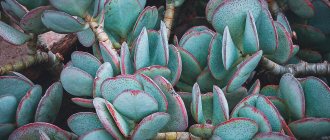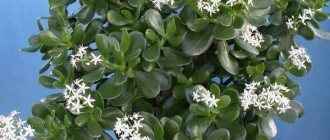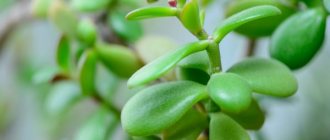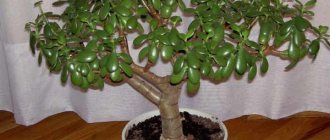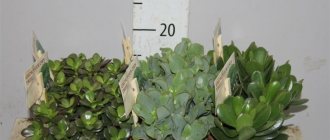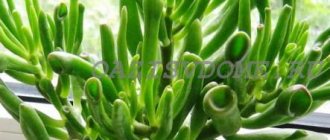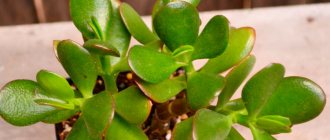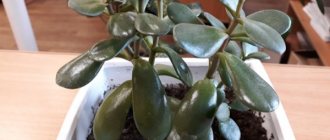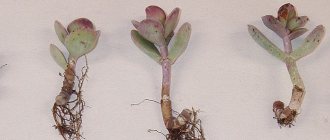The most popular, widespread and easy-to-grow type of indoor Crassula is Crassula ovalum, or Ovata - much better known as the money tree. The plant is credited with so many magical properties that the main thing - decorativeness and versatility - has almost been forgotten. You can believe or not believe in the myths about the money tree, but there is definitely no doubt that anyone can grow crassula oval. The main thing is not to overdo it with watering. And choose a brightly lit, warm place. Otherwise, care is more than easy.
Crassula oval, or Ovata - simplicity and perfection of the classics
Description
Crassula ovate is a semi-herbaceous plant that came to our windowsills from South Africa. Included in the TOP 5 best flowers for home growing.
Crassula ovate is a large, branching, compact and evergreen succulent plant. The shape of the bush is round. The plant blooms only in winter and spring.
Other characteristics of the plant:
- Stem . Thick, up to 20 cm in circumference. At the base it is knotty, from soft brown to gray.
- Branches. Small, proportionate, fleshy, their color is green with a slight gray tint, naked. If you look closely, you can see scars from fallen leaves. In mature plants, the bark peels off, forming brown horizontal ribbons.
- Leaves. Length 3-9 cm, width maximum 4 cm, shape – ovoid. The leaves are glossy, fleshy, flat, the tip is slightly pointed. Their main color is green, but depending on the variety, the shade can vary from gray to pale red. Near the edge there are nectar glands, their position is in rows, but randomly, found on both the upper and lower surfaces of the leaf.
- Peduncle. The inflorescence is corymbose-paniculate, apical, round in shape, can be dense or loose, but always with a large number of small flowers.
- Flowers. They have a star-shaped shape, their color is soft pink, there are 5 petals, and the aroma is unobtrusive. The sepals are broadly triangular, fleshy and have sharp tips. The corolla is white or slightly pinkish. The petals are oblong, sharp, spreading. Stamen filaments are about 5 mm with purple anthers. Pistil 2-3 mm long, thread-like.
- Fruits and seeds. The fruits of the Crassula ovoid are small capsules measuring 3-3.25 mm, each of which contains a large number of small seeds.
Money tree: description
The money tree comes from the smallest and at the same time the most species-rich floristic kingdom on Earth - the Cape Kingdom (lat. Capensis). This region borders directly on the Succulent Karoo, a hub of biodiversity, home to almost 2,000 different species of succulents. To survive in dry and hot regions, the money tree stores every drop of water in its fleshy leaves. As shown below, hobby gardeners benefit from this ingenious step of evolution in the form of simple plant care requirements.
The money tree belongs to the Crassulaceae family, which has more than 300 species. The plant is native to Southern and Eastern Africa, as well as Madagascar. It is known not only as the “money tree”, but also as the “tree of luck” and “tree of friendship”. Often grown as a houseplant.
The money tree grows in height from 50 to 130 centimeters. You can also find taller specimens. The plant grows rapidly when young, but growth activity decreases with age. Then the trunk and branches begin to thicken - this is the only way to become stronger and be able to support heavy leaves.
The leaves of the money tree are slightly oval in shape and curved at the top. They are flat on the underside.
Plants of the Crassulaceae family are characterized by the fact that they have fleshy leaves, the shoots are initially green, and then turn brown-gray.
Only after ten years does the money tree develop beautiful white or pink flowers. This is a special sight because the star-shaped flowers are very small and the stamens are convex and filigree. The money tree usually blooms in late winter or spring if it senses a temperature difference from summer to winter. To stimulate the flowering of the money tree, you can place it, for example, on a terrace or balcony in the summer. However, in early autumn the plant should return to the house.
Popular varieties of ovoid Crassula
Crassula ovata is a type of succulent plant that has its own varieties, of which there are more than 300. Not all of them are planted on windowsills, but only those that are especially popular. They are small in size, so they can be found in offices and entrance halls.
Ovata minor
The variety was bred by breeders. Distinctive features are compact size (about 50 cm) and slow growth. The trunk is erect, from which shoots extend. The leaves are small, 1.5 cm long and 1 cm wide. Variegated. Color – dark green with bright red edging.
If the plant is in a well-lit place, then you can enjoy all the richness of the color. Typically, Crassula Minor is used to create spectacular mini-gardens in residential settings.
Hobbit
A small succulent plant, the height of which is maximum 90 cm, the width of the bush is about 60 cm. The shape of the leaves is unusual - finger-shaped, tubular with concave tips, their length is up to 5 cm.
The color of the leaves can vary from soft green to rich green, the tips always have a red tint, which can be intensified by exposure to sunlight and low temperatures.
Ovata sunset
A variegated variety of Crassula ovata. This is a compact tree with a lush crown. The leaves are colored in several tones. In the middle - green, closer to the edges - creamy yellow.
In order for the plant to look as decorative as possible and be able to reveal all its flowering characteristics, it must be located in a well-lit place.
Gollum
The plant appeared by mixing Crassula Ovata and Milk. The leaves are in the form of an oblong tube, with expansion noted at the apex. Because of this shape, the leaves are called “Shrek ears.” Their color is green, with a purple rim along the edge.
Crassula Gollum grows very slowly, even in adulthood the maximum height is 50 cm.
The flower is often used to create bonsai. This is because the plant is compact and capable of independently forming an attractive crown.
How to grow Crassula ovata "Hobbit" or "Gollum" at home
Money trees are very popular succulents and people enjoy growing them indoors or outdoors. They often keep them not only for good luck, but also to decorate their home with ornamental plants. Tosltyanki ovoid varieties Hobbit and Gollum are slow-growing succulents, you need to be patient with them. We will describe the conditions in which your Crassula will feel good and delight you with its appearance.
The soil
Like any other succulent plant, Crassula 'Hobbit' and 'Gollum' need well-drained soil. Use a simple, well-draining potting mix. The best potting mix for succulents is mixed with perlite for extra drainage. The proportions are approximately 2:1. You can also add some sand to increase the drainage of the mixture. The proportions of the soil mixture will be as follows: fertile soil, perlite, coarse sand - 1:1:1.
More information on caring for succulents
How to prepare optimal soil for succulents: the best soil mixtures
What, how and when to fertilize succulents - expert advice
How to water succulents: what gardeners advise
Pot
To keep your succulent nice and compact, plant it in a pot that is the same size as the root ball. Crassulas can grow very large, reaching up to 90cm tall and 60cm wide (although they grow very slowly), and larger pots encourage more growth. So your pot size really depends on how big you want Crassula the Hobbit or Gollum to look.
However, keep in mind that larger pots contain more soil and therefore have a greater ability to retain moisture, which may increase the risk of root rot.
Lighting
Crassula ovoid varieties 'Hobbit' and 'Gollum' require at least 4-6 hours of sunlight to grow. Place the flower pot in a well-lit area in the room. Try a window facing east, south or west. These plants develop a deeper shade of green when stored in shade or partial shade. Their foliage becomes lighter and the red tips become more pronounced with more sun exposure.
If the plants begin to suffer from lack of light, move it to a brighter location. You'll know by the way they look. If the Crassula plants begin to stretch out, it means that the plant does not have enough light. This process is called etiolation. Flowers are literally looking for a light source. This results in weak and slow growth. Artificial lighting may be needed to supplement your plants' light needs, especially during these long, dark winters.
Temperature and humidity
Crassula ovata Gollum, like The Hobbit, prefers low to moderate room humidity. Store them in places with good air circulation and avoid increasing humidity.
Crassulas of these varieties grow well at room temperature. The succulent can tolerate a wide range of temperatures. Avoid frost. The optimal temperature range is 13 °C – 27 °C. Plants can be moved outside during the summer months and will benefit from doing so.
When summer temperatures exceed 27°C for an extended period of time, the flower slows down its growth to conserve its resources, especially moisture.
Watering Crassula ovoid "Hobbit" and "Gollum"
Succulents can tolerate moderate drought. So when it comes to watering, it is better to underwater than overwater. Overwatering can cause root rot, which is impossible to get rid of.
The need to water Crassula ovata 'Hobbit' or 'Gollum' will depend on the climate and time of year in your area. During the hot summer months, Crassula plants need to be watered every week. During cooler months, you may need to reduce watering every two weeks.
In winter, watering can be reduced to 2-3 weeks or stopped completely. It really depends on how quickly the soil dries out. Typically, succulents require watering when the top layer of soil becomes dry to the touch.
Fertilizer
Feeding these plants is not necessary, but giving them the nutrients they need will help promote proper growth and encourage flowering. Succulents require a lot of energy to start blooming, and feeding them with extra nutrients will help meet their needs during the flowering period. The most optimal period for applying fertilizers is during the active growing season or in the spring and summer months.
It is better to apply fertilizers at a quarter or half the dose specified by the manufacturer, approximately every two weeks. Refrain from fertilizing towards the end of the fall season and during the winter months.
Plant pruning
As they grow, the tubular leaves will weigh down your plant. Although they may shed some of their leaves on their own, trimming your flower will also help remove excess weight. Pruning can be done at any time of the year if you feel it is necessary, but it is best to do it in the spring or summer when your plant is actively growing.
You can learn more about succulents and pruning them from this video.
Rules for planting and transplanting
Planting Crassula ovoid at home is quite simple. The procedure is standard, but there are several rules:
- at the bottom of the pot, which is chosen specifically for the size of the seedling, there must be a drainage layer;
- immediately after planting, the plant needs to be watered;
- you should work carefully, as there is a risk of damaging the root system.
The money tree should be replanted regularly. This is a particularly important procedure for young specimens, since the plant grows rapidly and the roots require more space. It is recommended to replant once every 2-3 years.
The procedure should only be carried out in spring or summer. Winter is not a good time, because the plant is in a dormant stage and practically does not grow. If roots or other components are damaged, the tree may not recover.
Procedure for replanting a succulent:
- Place a new layer of drainage at the bottom of the pot.
- Add some soil.
- Remove the earthen lump from the roots.
- Insert the plant into the new soil while maintaining the depth.
- Press the fit firmly.
- Add the required amount of substrate.
After transplanting, place the plant in a partially shaded area for 3 weeks. Once the time is up (after 4 weeks), start watering the tree moderately.
Classification and description of succulents Crassula ovate “Hobbit” and “Gollum”
Plant classification
Scientific name: Crassula ovata 'Hobbit' (Crassula ovata 'Gollum') Synonyms: Crassula ovata 'Jade', Crassula portulacea 'Gollum', Crassula Ovata “monstruosa”, Crassula portulacea “hobbit”, Crassula argentea “Hobbit” Common name: Crassula ovata "Hobbit" (Crassulaceae "Gollum") Family: Crassulaceae (Crassulaceae) Subfamily: Crassuloideae Genus: Crassula (Crassula)
We're looking at these two varieties of fancy succulents in one article because these two related plants are no different when grown at home. Their main difference is the size and shape of their leaves. Many people guess that these plants got their names from the books of J. R. R. Tolkien. Both varieties were bred in nurseries and are not found in nature. These two plants are very similar to each other and are often confused.
Both varieties are small, moderately branched, slow growing, erect shrubby plants up to 50-80 cm in height and 30-60 cm in width. They differ in the shape of the leaf blades from their “parent” - Crassula ovate.
What is the difference between the Crassula ovata varieties “Hobbit” and “Gollum”
Both have leaves rolled into a tube. Crassula "Gollum" has elongated, almost tubular leaves that form a round sucker at the tip. The leaves of Crassula 'Gollum' are more tube-like, with a slightly reddish interior at the base of the suckers, and most are all green.
Photo of Crassula leaves Hobbit (left) and Gollum (right)
In the Crassula “Hobbit” variety, the leaves are less elongated into a tube; they have a more open and oval shape. The leaves are fleshier and thicker, and their tips are colored red. In this video, a famous succulent breeder on his Crassulas explains the differences between the varieties Gollum, Hobbit, Coral, Legolas, Gimli and Red Horn
The deviation of the Crassula Gollum and Hobbit varieties from the usual type of Crassula ovata is considered to be the result of a mutation caused by the bacterium “mycoplasma”. The mutation causes the naturally occurring flat leaves to curl and fuse together to form a distinct tubular appearance.
They have a strong, segmented, branching stem that is easy to shape and is often shaped into different shapes to create spectacular bonsai forms.
The flowers bloom in clusters, are small, star-shaped, white or pinkish-white, with pink stamens. The flowering season for Crassula the Hobbit and Gollum is late autumn and early winter. But they will bloom only in ideal conditions.
How to care for ovoid crassula?
Crassula ovate is a succulent that does not require special skills from the gardener in the field of care and maintenance of indoor plants. It is enough to select the right comfortable living conditions for the tree once and periodically carry out a series of simple procedures.
Crassula Ovata is native to a hot and arid continent, so it can survive even in the harshest conditions.
How to choose a pot and substrate?
When choosing a flowerpot for planting Crassula ovata, you need to look at the size of the root system. Usually it is much smaller than the ground part. The root develops in breadth and not in depth, so it is required that the pot has a 4 cm layer of drainage. This can be played by:
- pebbles;
- expanded clay;
- debris from bricks or ceramic materials;
- gravel or fine crushed stone.
It is better not to consider pots made of plastic or other lightweight materials. The plant may grow too large for the pot and it may tip over, damaging the tree. The optimal solution is a shallow container made of clay.
It is believed that the money tree grows best in pots of dark colors: brown, black, dark red. They imitate the shade of the soil. But this statement has not been proven.
It is preferable to use a mixture of 3 parts soil, 1 part coarse sand or perlite as soil for planting succulents.
Which place is better?
It is best to keep a pot with Crassula ovoid in a place well lit by the sun. The plant also reacts positively to dark areas. The ideal solution for wood is a window sill facing East.
Several rules for choosing the location of a succulent:
- You can place a flower on the south side, but not in the summer. The scorching rays of the sun can cause burns on the leaves, which will first darken and fall off.
- The northwestern direction can be chosen only in one case - the plant is standing on a windowsill in a high-rise building without close proximity to shading elements.
- The room must have a powerful ventilation system. The fat plant needs fresh air, this is the only way the plant will bloom beautifully and develop properly. In addition, air circulation helps keep humidity within normal limits.
- Even acceptable lighting needs to be dosed by turning the pot with different sides to the luminary.
Humidity and temperature
You need to approach the selection of temperature conditions responsibly and take into account several rules:
- during the period of intensive growth, the plant needs heat - about +25 degrees;
- in winter – cooler conditions, no more than +12 degrees.
Crassula ovata grows well in a room with moderate humidity. A high rate can cause suppuration of the stem and leaves, and too dry air will cause leaves to fall off.
How to water?
During the spring and summer, the succulent tree needs regular watering. But it is unacceptable to over-moisten the soil in the pot. Otherwise, the process of rotting of the root system will begin, which will lead to the death of the plant.
Watering is started when the soil is 2/3 dry.
When cold weather sets in, the fat plant is transferred to a cool room. The plant is at a dormant stage at this time and does not need to be watered. Otherwise, the combination of cold and soil moisture will lead to the death of the flower.
A complete refusal to water and reducing it to minimum volumes in winter will not have a negative effect on the plant. The fleshy leaves contain enough moisture to survive dormancy without additional water.
If the leaves begin to wrinkle in winter, this indicates that the plant needs to be watered immediately.
Feeding and fertilizer
When the weather remains warm on the street and on the windowsill, the Oval Crassula should be fed once a month. Subtleties of fertilizing:
- Before starting the procedure, you need to water;
- substances are introduced into the soil one day after it is moistened;
- You can use specialized compounds for succulents and cacti;
- mullein, which has been aged for 1 month and diluted in a ratio of 1:10, can serve as a top dressing.
Reproduction
You can propagate Crassula ovata in several ways, which are equally promising:
- Stem cuttings. To propagate the crassula by a similar method in the spring, at the end of flowering, fresh, particularly green shoots located at the end of the branch are cut off. How to proceed:
- In spring, trim the tips of the shoots, their length is from 10 to 15 cm;
- Break off the leaves at the bottom;
- Leave the sections to dry, 2 days is enough.
- Place the cutting in a glass of water. More than 50% of the section must be immersed in liquid. This is necessary for root germination.
- Make sure the soil is always moist.
- Leaf cuttings. This option is relevant only in one case - when you do not want to deprive the plant of shoots 15 cm long or to obtain a large number of new young succulents. One feature worth considering is that the roots take much longer to form and grow. How to propagate a money tree correctly in this case:
- Break off or cut off the fleshiest and greenest leaf from the shoot.
- Leave the wound to dry for 3 days.
- Fill the pot with substrate.
- Place the cutting about 1cm deep into moist soil.
- Place a match as a support. At the base of the leaf cutting, a miniature tree grows, developing its own root system. Once it has formed to a few cm (about 10), cut the leaf using an alcohol-treated razor blade.
How to propagate Crassula ovata The Hobbit (or Gollum)
You can propagate Crassulas from leaves or stem cuttings. The easiest way is stem cuttings. When using leaves, it is better to use several leaves because not all of them will produce offspring.
How to propagate Crassula "Hobbit" and "Gollum" from stem cuttings
- Separate part of the stem and let it dry for a day or two. It is recommended to take cuttings from a healthy flower rather than from dehydrated or stressed plants. You can dip the cut end in rooting hormone;
- When the cutting is healed and dry, place the cuttings in well-draining soil;
- Protect the pot from direct sunlight. Water or mist the soil every few days or when it seems dry;
- After about two weeks, you will notice the appearance of new roots;
- After about four to six weeks, sometimes longer, the cuttings should be fully rooted and you'll soon notice new leaves on the top or sides of the stem;
- Once fully established, reduce spraying and switch to regular watering about once a week or less. Increase the amount of sunlight as the plant matures.
How to propagate Crassula 'Hobbit' or 'Gollum' leaves
- Carefully separate the leaf, making sure you have the entire leaf, including the base. You can twist the leaf a little - it should come off. Choose healthy, fleshy leaves. It's best to separate more than one leaf just because not all of them will germinate;
- You can dip the cut ends in rooting hormone. It can help speed up the reproduction process;
- Wait for the leaves to dry, about a day or two. Store in a dry place, protected from direct sunlight;
- Prepare a soil mixture with good drainage. After drying, lay the leaves on the ground;
- The leaves should take root in about 2 weeks. After a few more weeks, you will notice the appearance of new growth. The entire process can take from several weeks to months.
Difficulties in growing the species
Usually, there are no problems with growing an ovoid crassula if you take into account all the characteristics of the plant and adhere to the basic rules. If the procedure is neglected, a number of problems may arise:
- The money tree stopped growing after transplantation. The procedure is carried out using a larger pot.
- It is not possible to maintain the compact size of the plant. In this case, when replanting, you need to use the same pot, and not more. The roots are cut directly above the scars of old leaves. Then new leaves will begin to grow from this place.
- The roots rot. It is necessary to normalize watering of the plant, check and adjust the temperature and air humidity.
- The leaves wrinkle. Most likely the cause was the location of the pot near the radiator of the battery.
- The leaves have turned brown. This indicates a lack of moisture.
The winter months for the money tree are considered to be from October to March. Crassula oval tolerates well, if you take into account several points:
- the plant requires a dry, calm and cool climate;
- good temperature indicators from 5 to 13 degrees with a + mark;
- watering stops in winter;
- During the dormant period, the plant is not fertilized.
Varieties of Crassula ovoid (oval) with photo
And this is what different varieties of oval crassula look like in the photo.
"Gollum" (The Hobbit)
Crassula ovata cv. Gollum (Hobbit) has unusual leaves, wrapped in a tube, with ends expanded in the form of a funnel . Capable of growing up to 80 cm.
"Tricolor"
Crassula ovata ssp. obliqua variegata cv. Tricolor has a red border and white stripes on its leaves. To prevent the plant from losing its decorative qualities, young shoots must be removed.
"Solana"
Crassula ovata ssp. obliqua variegata cv. Solana has leaves with asymmetrical yellow stripes . But if you do not remove the green shoots of the plant, it will lose its variegation.
"Horn Tree"
Crassula ovata "Horn Tree" has decorative leaves. When they are young they don't look special, but as they grow they form a half-coiled tube. Some varieties have a bright red leaf tip.
"Mix"
Crassula ovata “Mix” (Crassula ovata “Mix”) is a shrub with a powerful trunk, a large number of shoots and oval leaves . There is a red border along the edges of the leaves.
"Hummel's Sunset"
Crassula ovata variegata cv. Hummel's Sunset has leaves with red edges, decorated with white and yellow stripes. If the light is not intense enough, the leaves turn green.
"Minor"
Crassula ovata "Minor" (Crassula ovata v. minor cv. Crosby's Compact) is a plant with small oblong leaves bordered with red along the edges.
"Obliqua"
Crassula ovata ssp. Obliqua is a not very common variety. It has large leaves, slightly curved downwards on the sides and with a raised tip.
Formation of a tree
It is easy to grow a bonsai using an egg-shaped succulent. It lends itself well to shaping. Usually the procedure is carried out in the spring. This is necessary for the plant to get stronger. How to form a fat plant depends on the personal preferences of the grower.
A decorative money tree can be made into a fluffy ball, a tall tree, or an original plant with curved stems in an exotic style.
It is worth considering the fact that the succulent sheds its leaves from below, exposing the brown stem. The money tree should be pruned 1 or 2 times a year. Things to remember:
- a sunny day is chosen in March;
- shoots that are too long are shortened to the desired length;
- place the scissors just above a pair of healthy leaves;
- after pruning there should be no stumps left.
Crassula is a non-poisonous plant, so you can operate without gloves; the scissors must be thoroughly disinfected and well sharpened. The smoother the cut, the lower the risk of infecting the plant.
After pruning, the plant will form more densely. Always make straight cuts and cut only along thin grooves, such as where a leaf has fallen off.
Reproduction of the Oval Crassula
The simplest method of propagating the Ovata Crassula and Lycopodidae is cuttings. For this purpose, a young shoot with several adult leaves is cut with a sharp blade. You can cut off large leaves; they also take root well. Then the cuttings are left to dry a little for 2-3 hours, after which the cut is treated with activated carbon or a special growth stimulator. The prepared cuttings are planted in a separate container.
Crassula Ovata is best propagated by cuttings.
Diseases and pests
If you regularly make mistakes when maintaining a money tree, it can get sick. The following will appear:
- mealy or root bug;
- aphid;
- sciarids;
- flower midges;
- wine weevil.
Specialized means of different effects or folk methods will help get rid of parasites, but the first thing to do is to eliminate the cause of the disease and replace the soil in the pot, which has been treated with fungicides.
When choosing an insecticide, you should check whether it is suitable for succulents. Before use, carefully read the instructions, otherwise you may harm the plant.
Varieties
There are many varieties of this variety. They are distinguished from each other by the shape of the foliage and its quantity on the plant. Some representatives of the Ovata species have narrow, oval-shaped leaves, others are pointed, and others are monstrous. There are also plants devoid of foliage.
In the list of Crassula varieties of the Ovata species that are popular among gardeners, you can see:
- Nammel's Sunset';
- Tricolor;
- Solana;
- Horn Tree;
- Mix;
- Minor;
- Appearance.
Among the most unusual representatives of the species are the so-called monstrous forms of the plant . They are named after the characters in the popular novel The Lord of the Rings by John Ronald Tolkien:
- Hobbit;
- Gollum.
